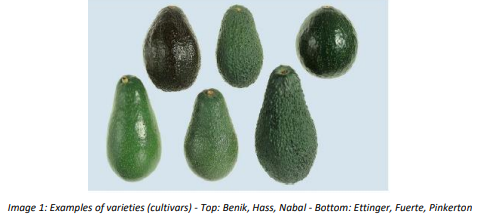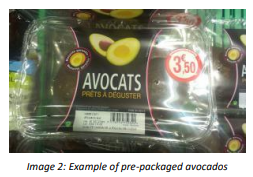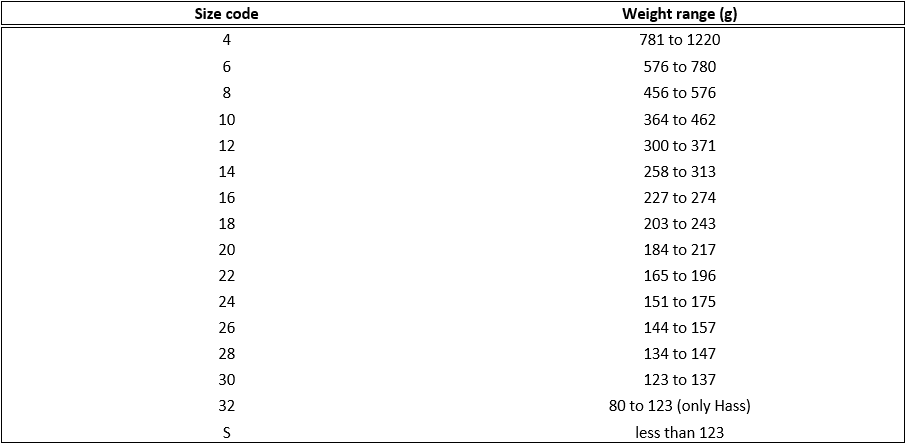- Product description / classification: which product(s)?
- What are the mandatory requirements?
- Labeling and packaging
- Quality requirements
- What additional requirements do buyers often have?
- What are the requirements for niche markets?
Product description / classification: which product(s)?


What are the mandatory requirements?
When exporting Avocados to Netherlands, you have to comply with the requirements for food safety and product quality.Pesticides Residues
To avoid health and environmental risks, the European Union (EU) has set maximum residue levels (MRLs) for pesticides in and on food products. Products exceeding the MRLs, are withdrawn from the market. For substances that are not yet included in the European regulation, the default MRL of 0.01 mg/kg applies.
Note that buyers in several Member States such as the Netherlands the United Kingdom, Germany, and Austria use MRLs, which are stricter than the MRLs, laid down in European legislation. Supermarket chains maintain the highest standards and generally demand 33% to 100% of the legal MRL.
For importers, it is easiest to work with the highest (Lidl) standard to maintain flexibility. Supermarkets tend to follow their competitors, and several of them may still tighten their requirements. Some of the supermarket chains impose financial penalties when a violation of their limit is detected.
Pesticide management takes a lot of responsibility on your part as a producer or exporter. More and more buyers ask for upfront information about your pesticide spray records. Shipments are checked before they are sent to the retailer. For future business, you must take into account that your responsibility as an exporter will play an important role as retail chains put more pressure on their suppliers.
Note that buyers in several Member States such as the Netherlands the United Kingdom, Germany, and Austria use MRLs, which are stricter than the MRLs, laid down in European legislation. Supermarket chains maintain the highest standards and generally demand 33% to 100% of the legal MRL.
For importers, it is easiest to work with the highest (Lidl) standard to maintain flexibility. Supermarkets tend to follow their competitors, and several of them may still tighten their requirements. Some of the supermarket chains impose financial penalties when a violation of their limit is detected.
Pesticide management takes a lot of responsibility on your part as a producer or exporter. More and more buyers ask for upfront information about your pesticide spray records. Shipments are checked before they are sent to the retailer. For future business, you must take into account that your responsibility as an exporter will play an important role as retail chains put more pressure on their suppliers.

Tips
- Use the EU Pesticide Database to find out the MRLs that are relevant for your products. You can select your product or a pesticide and the database shows the list of associated MRLs. Always check whether your buyers have additional requirements for MRLs and pesticide use.
- Apply integrated pest management (IPM) to reduce the amount of pesticide. IPM is an agricultural pest control strategy, which is also part of GLOBALG.A.P. Certification. It uses natural control practices such as the application of pests’ natural enemies. The fewer chemicals you use, the better your marketing position will be for export to Europe.
Contaminants - Avoiding contaminants
Contaminants are substances that were not intentionally added to food. They may
be present because of the various stages of its production, packaging, transport
or holding. Similar to the MRLs for pesticides, the European Union has set
limits for several contaminants. For fresh fruit and vegetables, your main
concerns will be the contamination of lead, cadmium and nitrate. Make sure that
lead contamination in your avocados remains below 0.10 mg/kg and cadmium below
0,050 mg/kg, according to the maximum levels contaminants in foodstuffs.

Tips
- Maintain good contact with your buyers, because they will often keep you up to date with changes in regulation, which affect the fresh fruit and vegetables business.
- Read more about contaminants on the website of the European Commission and find an overview of the maximum contaminant levels in the Annex of Regulation (EC) 1881/2006. Try to check this information on an annual basis.
- Find out more about the prevention and reduction of lead contamination in the Code of Practice published by the FAO Codex Alimentarius.
- Check the European Commission’s fact sheet on food contaminants managing food contaminants: how the EU ensures that our food is safe.
Phytosanitary regulations
The
new European Directive
(2019) requires avocados to go through plant health checks before entering the
European Union. The plant health inspection must take place in the country of
origin. Avocados require phytosanitary certificates prior to shipping.
Phytosanitary certificates are provided by plant health authorities and must
guarantee that a product is:
MOA is the national authority issuing the phytosanitary certificate link
- Properly inspected;
- Free from quarantine pests, within the requirements for regulated non-quarantine pests. Practically free from other pests;
- In line with the plant health requirements of the EU, laid down in Regulation (EU) 2019/2072.
MOA is the national authority issuing the phytosanitary certificate link

Tips
- Learn more about the European phytosanitary rules in Council Directive 2000/29/EC and the new Implementing Directive 2019/523 on the protective measures against the introduction of harmful organisms in the European Union.
- Check which (other) fruit and vegetables require a phytosanitary certificate in the lists of Annex XI and Annex XII of Regulation (EU) 2019/2072).
Labeling and packaging
Size and packaging
Food placed on the EU market must meet the legislation on food labelling.

Uniformity
The contents of each package must be uniform and contain only avocados of the same origin, variety, quality, coloring and size. The
visible part of the contents of the package must be representative of the entire contents. Presentation should not be misleading.
Packaging
Avocados must be packed in such a way as to protect the produce properly. Packages must be of a quality, strength and characteristic
to protect the produce during transport and handling. The materials used inside the package must be clean and of a quality such as
to avoid causing any external or internal damage to the produce.
The use of materials, particularly of paper or stamps bearing trade specifications, is allowed, provided the printing or labelling has been done with nontoxic ink or glue. Stickers individually affixed to the produce shall be such that, when removed, they neither leave visible traces of glue nor lead to skin defects. Information lasered on single fruit should not lead to flesh or skin defects. Packages must be free of all foreign matter. Clean materials should be used to protect the produce from foreign matter such as leaves, sand or soil, which could cause a negative impact on the produce and its presentation. A visible lack of cleanliness in several packages could result in the goods being rejected.
Packaging requirements vary between customers and market segments. Avocados must at least be packed in new, clean and quality packaging to prevent damage and protect the product properly. Common packaging includes:
The use of materials, particularly of paper or stamps bearing trade specifications, is allowed, provided the printing or labelling has been done with nontoxic ink or glue. Stickers individually affixed to the produce shall be such that, when removed, they neither leave visible traces of glue nor lead to skin defects. Information lasered on single fruit should not lead to flesh or skin defects. Packages must be free of all foreign matter. Clean materials should be used to protect the produce from foreign matter such as leaves, sand or soil, which could cause a negative impact on the produce and its presentation. A visible lack of cleanliness in several packages could result in the goods being rejected.
Packaging requirements vary between customers and market segments. Avocados must at least be packed in new, clean and quality packaging to prevent damage and protect the product properly. Common packaging includes:
- 4 kg cardboard boxes, often wholesale packaging;
- 10 kg plastic or cardboard crates, often for importers that ripen and repack avocados.

Tips
- Always discuss specific packaging requirements and preferences with your customers.
- Check the additional requirements if your product is pre-packed for retail in the Codex General Standard for the Labelling of Prepackaged Foods or Regulation (EU) No. 1169/2011 on the provision of food information to consumers in Europe.
- Find the legal requirements for labelling in the buyer requirements for fresh fruit and vegetables on the CBI market information platform.
Provisions Concerning Marking
Each package must bear the following particulars, in letters grouped on the same side, legibly and indelibly marked, and visible from
the outside: In the case of packed produce, all particulars must be grouped on the same side of the package, either on a label attached
to or printed on the package with water-insoluble ink. In the case of reused packages, all previous labels must be carefully removed
and/or previous indications deleted.
Identification
Nature of produce
Origin of produce
Commercial specifications
Additional information on the package
Identification
- Packer and/or dispatcher/exporter:
- Name and physical address (e.g. street/city/region/postal code and, if different from the country of origin, the country) or a code mark officially recognized by the national authority if the country applying such a system is listed in the UNECE database.
- For inspection purposes, the “packer” is the person or firm responsible for the packaging of the produce (this does not mean the staff that actually carry out the work, who are responsible only to their employer). The code mark is not a trademark, but an official control system enabling the person or firm responsible for packaging to be readily identified. The dispatcher (shipper or exporter) may assume sole responsibility, in which case identification of the “packer” as defined above is optional.
Nature of produce
- "Avocados" if the contents are not visible from the outside. The name of the produce may be replaced by a photo or drawing of the produce.
- Name of the variety. The name of the variety is compulsory for all classes
Origin of produce
- Marking must include the country of origin, i.e. the country in which the avocados were grown (e.g. “Produce of Lebanon“).
- Optionally, marking might include district where grown, national, regional or local place name.
- The indication must be with the full name or a commonly used name. Abbreviations or acronyms are not allowed.
- On the other hand, the full name of a country is the official name of the country (e.g. Kingdom of the Netherlands). The commonly used name is e.g. the Netherlands or Holland for the Kingdom of the Netherlands.
Commercial specifications
- Class; Stating the class is compulsory.
- Size expressed as
- minimum and maximum weights or
- count or
- code number of the size scale
- code number of the size scale and the net weight of the package or
- in case of sales packages (pre-packages): net weight. However, in the case of products sold by number, the requirement to indicate the net weight shall not apply if the number of items may be clearly seen and easily counted from the outside or, if the number is indicated on the label.
Additional information on the package
- Lot number for traceability or GGN if certified GLOBALG.A.P. (recommended);
- Official control mark to replace name and address of the packer (optional);
- Post-harvest treatment; for example, anti-moulding agents added in a post-harvest treatment of citrus fruits must be mentioned on the trade package;
- Organic certification, including name of inspection body and certification number (if applicable).
Quality requirements
At the very least, avocados should comply with the general quality requirements (see Table 1). At a minimum, Europe almost exclusively requires Class I avocados. Avocados in this class need to be good quality and any defects within the permissible tolerance levels. In no case may the defects affect the fruit flesh, the general appearance of the produce, the quality, the keeping quality and presentation in the avocado packaging.General quality requirements (all classes)
1. Intact: Avocados must not have any damage or injury affecting the integrity of the produce
2. Produce affected by rotting or deterioration such as to make it unfit for consumption is excluded such as:
3. Clean, practically free of any visible foreign matter: Avocados must be practically free of visible soil, dust, chemical residue or other visible foreign matter
4. Free from pests
5. Free from damage caused by pests affecting the flesh
6. Free from damage caused by low temperature
7. Have a stalk no longer than 10 mm in length
8. Free of abnormal external moisture
9. Free of any foreign smell and/or taste
10. The development and condition of the avocados must be such as to enable them to withstand transportation and handling and to arrive in satisfactory condition at the place of destination
2. Produce affected by rotting or deterioration such as to make it unfit for consumption is excluded such as:
3. Clean, practically free of any visible foreign matter: Avocados must be practically free of visible soil, dust, chemical residue or other visible foreign matter
4. Free from pests
5. Free from damage caused by pests affecting the flesh
6. Free from damage caused by low temperature
7. Have a stalk no longer than 10 mm in length
8. Free of abnormal external moisture
9. Free of any foreign smell and/or taste
10. The development and condition of the avocados must be such as to enable them to withstand transportation and handling and to arrive in satisfactory condition at the place of destination


Maturity
The development and state of maturity of avocados must be such as to enable them to continue their ripening process and to reach
a satisfactory degree of ripeness. The fruit should have a minimum dry matter content, measured by drying to constant weight:
For importers that ripen avocados, 23% of dry matter for Hass avocados is often a minimum. Maturity must be uniform throughout the parcel.
The ripe fruit should be free from bitterness.
- 21% for the variety Hass;
- 20% for the varieties Fuerte, Pinkerton, Reed and Edranol;
- 19% for other varieties, except for Antillean varieties that may show a lower dry matter content.
For importers that ripen avocados, 23% of dry matter for Hass avocados is often a minimum. Maturity must be uniform throughout the parcel.
The ripe fruit should be free from bitterness.

Tips
- Verify with your buyer their preferences on checking maturity. Suppliers use different measuring methods and product standards may differ per country and per variety.
Classification
Avocados are classified in three classes, as defined below:
I. “Extra” Class
Avocados in this class must be of superior quality. They must be characteristic of the variety. They must be free from defects, with the exception of very slight superficial defects. These defects should not affect the general appearance of the produce, the quality, the keeping quality and presentation in the package. If present, the stalk must be intact.
II. Class I
Avocados in this class must be of good quality. They must be characteristic of the variety. The following slight defects, however, are allowed provided these do not affect the general appearance of the produce, the quality, the keeping quality and presentation in the package:
III. Class II
This class includes avocados that do not qualify for inclusion in the higher classes but satisfy the minimum requirements specified above. Avocados in this class must be of reasonable quality and suitable for human consumption. The following defects may be allowed provided the avocados retain their essential characteristics as regards the quality, the keeping quality and presentation:
In no case may the defects affect the fruit flesh. The stalk, if present, may be damaged.
Additional requirements and permissible tolerances for Class I avocados
I. “Extra” Class
Avocados in this class must be of superior quality. They must be characteristic of the variety. They must be free from defects, with the exception of very slight superficial defects. These defects should not affect the general appearance of the produce, the quality, the keeping quality and presentation in the package. If present, the stalk must be intact.
II. Class I
Avocados in this class must be of good quality. They must be characteristic of the variety. The following slight defects, however, are allowed provided these do not affect the general appearance of the produce, the quality, the keeping quality and presentation in the package:
- slight defect in shape;
- slight defects in coloring;
- slight skin defects (corkiness, healed lenticels) and sunburn, provided they are not progressive; the maximum total area should not exceed 4 cm2. In no case may the defects affect the fruit flesh. The stalk, if present, may be slightly damaged.
III. Class II
This class includes avocados that do not qualify for inclusion in the higher classes but satisfy the minimum requirements specified above. Avocados in this class must be of reasonable quality and suitable for human consumption. The following defects may be allowed provided the avocados retain their essential characteristics as regards the quality, the keeping quality and presentation:
- defects in shape;
- defects in coloring;
- skin defects (corkiness, healed lenticels) and sunburn, provided they are not progressive; the maximum total area should not exceed 6 cm2.
In no case may the defects affect the fruit flesh. The stalk, if present, may be damaged.
- Slight defects in shape
- Slight defects in coloring
- Slight skin defects (corkiness, healed lenticels) and sunburn, provided they are not progressive; the maximum total area should not exceed 4 cm2
- The stalk, if present, may be slightly damaged
- A tolerance of 10% is allowed for fruit that meets Class II standards
- A tolerance of 10% in number or weight is allowed for avocados not meeting the sizing requirements.



Tips
- Maintain strict compliance with quality, delivering it as agreed with your buyer. Being careless with your standards will lead buyers to raise issues with quality. To avoid miscommunication, send images of your product before shipment.
- Negotiate with your buyer to include different sizes and mixed pallet per shipment. Make sure the sizes are the same per pallet.
- Check the OECD International Standardisation of Fruit and Vegetables – Avocados, which has images of the types of avocados and damages allowed.
Provisions Concerning Sizing
The size is determined by the weight or count of the fruit. To ensure uniformity in size between produce in the same package, the following size scale applies:
The difference between the smallest and largest fruit within a package should not be more than 25 g.
In Europe, the preferred sizes for Hass avocados are 16–18, and sometimes 20 per 4 kg box. For the Fuerte variety, 14–16
The difference between the smallest and largest fruit within a package should not be more than 25 g.
In Europe, the preferred sizes for Hass avocados are 16–18, and sometimes 20 per 4 kg box. For the Fuerte variety, 14–16

What additional requirements do buyers often have?
Variety
Hass is the most demanded avocado variety in Europe, especially in Netherlands and the United Kingdom. The Hass variety is very suitable for ripening. Green skin avocados still have their own niche. However demand is dropping. Pinkerton avocados, also known as pseudo Hass, have a specifically timed demand because it is a late variety.
Certification
Avocados have become a typical product in retail programmes. As a result, buyers
almost always require a set of certifications to demonstrate good practices and
food safety. Common certifications include GlobalG.A.P. for agricultural
production and BRCGS, IFS or similar HACCP-based food safety management systems
for packing houses. These management systems are recognised by the Global Food
Safety Initiative (GFSI).
In the near future, you can expect new standards and buyer requirements to be introduced. For example, the Sustainable Trade Initiative for Fruit and Vegetables (SIFAV), a private covenant between European importers and retailers, is formulating new goals towards 2025 that include reducing the carbon footprint and increasing sustainable water use. With this in mind, it is sensible to measure your environmental impact and explore new standards such as SPRING, a Global G.A.P. add-on for sustainable irrigation and groundwater use, or the Corporate Carbon Footprint of TÜVRheinland.
In the near future, you can expect new standards and buyer requirements to be introduced. For example, the Sustainable Trade Initiative for Fruit and Vegetables (SIFAV), a private covenant between European importers and retailers, is formulating new goals towards 2025 that include reducing the carbon footprint and increasing sustainable water use. With this in mind, it is sensible to measure your environmental impact and explore new standards such as SPRING, a Global G.A.P. add-on for sustainable irrigation and groundwater use, or the Corporate Carbon Footprint of TÜVRheinland.

Tips
- Implement at least one environmental and one social standard. See the Basket of Standards of The Sustainable Trade Initiative for Fruit and Vegetables (SIFAV).
- For other additional requirements such as payment and delivery terms, see the CBI’s reports on buyer requirements for fresh fruit and vegetables and the tips for doing business with European buyers.
What are the requirements for niche markets?
The market for organic avocados is relatively small, but with growing demand and limited supply. Organic avocados are especially interesting for consumers who value avocados for their healthy aspects.To market organic products in Europe, you must use organic production methods according to European legislation and apply for an organic certificate with an accredited certifier. Note that in January 2021 the new legislation Regulation (EU) 2018/848 will come into force. Inspection of organic products will become stricter to prevent fraud and producers in third countries will have to comply with the same set of rules as those producing in the European Union.

Tips
- Consider organic avocados as a plus, not as a must. Remember that implementing organic production and becoming certified can be expensive. You must be prepared to comply with the entire organic certification process.
